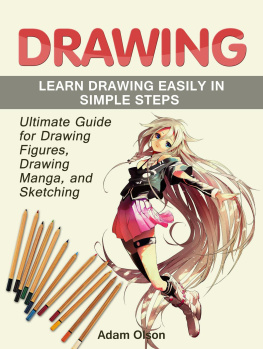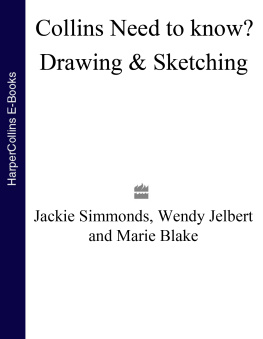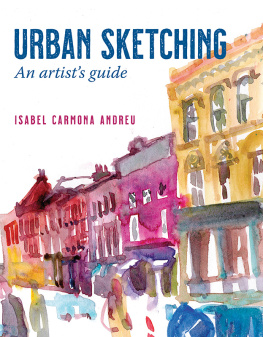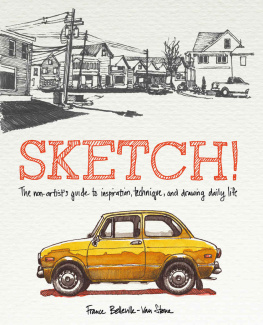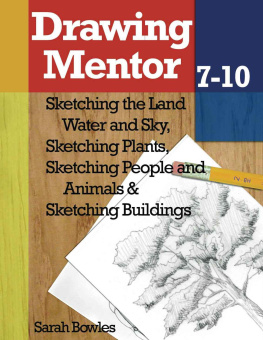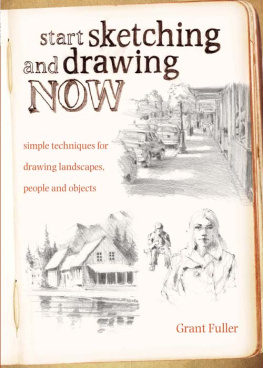INTRODUCTION
This book is about telling stories with drawings, so its only fitting that it begins with the story of how I became an artist.
I accidentally started what would become my Drawn on the Way project while commuting in New York City on the F train one evening in 2012. I am not a trained artist; in fact, Id never even tried to sketch anyone before. But, tired of staring at a screen, I took out the blank notepad I had stashed in my purse and a pen stolen from the office supply closet at work and looked up for inspiration.
An older gentleman in a rumpled three-piece suit and matching fedora caught my eye and I sketched him, not knowing that in the midst of my evening commute, I had started what would become a daily live-sketch project that would generate thousands of sketches and introduce me to people from all over the world. I began sharing my daily drawings, first by giving them to the people who inspired them, then by letting fellow commuters watch over my shoulder, and finally by sharing them on social media. I marveled at the way these moments, captured quickly in my sketchbooks, could create community and connection, and it inspired me to keep drawing and to keep tuning in to these often-overlooked on-the-way moments.
The subway may seem like an unlikely place to go to art school, but it was there I found my best teachers: time, repetition, and mistakes. Together they taught me everything I needed to know about drawing from life and doing it in my own style.
I only had a little time, a little sketchbook, a bumpy subway ride, and a simple pen to describe what I saw on the way. Because I didnt let that hold me back, I discovered my own way of doing itmy own approach.
As a self-taught artist, I didnt want to write a book full of rules that would erase all the wonderful, creative ideas sitting in your head right now, just waiting to get out.
This is more than a book about how to draw. This is a book about how to see: how to see the world differently, as a place filled with stories; how to see the people around you differently, as works of art; and how to see yourself differently, as someone whose voice has a place, even if its just in the private pages of your own sketchbook.
This book is a warm invitation to engage your own creativity, using simple supplies and a universal and ever-present source of inspiration: the world. This book will not teach you how to draw like me; rather, it will guide you through the process of drawing from life in your own style.
This is a book about drawing, but its also a book about living.
I hope this book makes you curious about your world and your place in it. Curiosity, empathy, joy, and wonder are foundational to the techniques explained here. And just like the materials youll use to make your drawings, you can carry this worldview with you everywhere.
CHAPTER 1
TOOLS AND MATERIALS
Although I believe there are very few hard-and-fast rules for creating art in your own unique style, I have found that a nonnegotiable requirement for drawing is having something to make marks with and something to make those marks on.
In this chapter, well review the basic materials we need for drawing on the way. Well also learn about the importance of choosing the right tools based on what they can do for usand what they can teach us.
Keeping It Simple
While there are many technical reasons to choose a particular pen or type of paper, lets talk about the less obvious reasons why the materials you choose are important to the art you make.
For nearly a decade now, Ive made portraits with just an ordinary office pen, and its been more than enough. I suggest that you keep it simple at first, and focus on using only a pen for your on-the-way drawings. Using one basic tool removes the anxiety that comes with having too much creative choice. The constraint of having one tool to generate shapes, colors, textures, and patterns will force you to be innovative and to explore.
There is another reason for using a pen: Where were going, you wont need erasers. A huge part of the joy and purpose youll find in drawing from life is how it connects you to your creative self. An eraser interrupts that connection because it suggests that there is a right and wrong to what you are doingand this is simply not true.
Drawing without an eraser, youll tap into your instincts. And I promise you that you do have creative instincts, because all humans do.
Without an eraser, each line becomes an act of bravery. Youll see the full record of your artistic process. The lines that dont communicate what you want will sit right next to the ones that do. Each line becomes a lesson, a teacher in its own right. Dont allow your fear of making mistakes to rob you of this education. There will be a time for erasers, but now is not that time. Now is the time to allow yourself to exist unfiltered on the page.
LIVING YOUR LIFE IN INK
Without an eraser, there is no going back. When it comes to the work at hand, there are only three choices: Accept what youve made as good and move on; turn the page and start over; or work with your mistakes and turn them into something you like. These are the constraints of working in pen, but they mirror the choices we have at any given moment in life. So lets leave our erasers behind and boldly begin.
The Basics
You dont need fancy supplies to make great art. Use whats on hand and try a few options. Once you find something you like, stick with it for a while and get to know it before trying something new.
PENS
Here are a few of my favorite pens, with some pros and cons for each.
Rollerball Pens
A rollerball pen has a rolling ball at the tip of the pen that is inked by a reservoir above it. This is my preferred type of pen. Every drawing in this book was made with the uni-ball Roller pen in blue with a 0.7 mm point.
WHATS NICE ABOUT THEM:
- - Smooth ink flow (similar to a fountain pen)
- - Vibrant color


